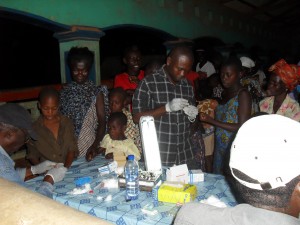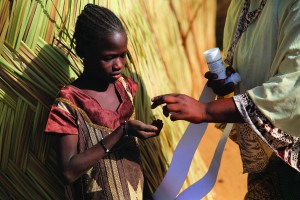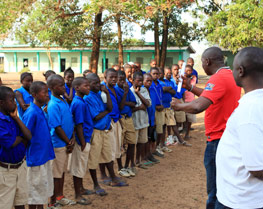With Progress Comes Challenges: As Countries Approach Lymphatic Filariasis and Trachoma Elimination, NTD Programs Look for Ways to Verify, Hang onto Success
November 18th, 2014
After years of grassroots outreach and nationwide travel to provide preventive medicines to millions of citizens, even those living in the most remote communities, END in Africa countries have good reason to celebrate the progress achieved in their fight against neglected tropical diseases (NTDs), especially lymphatic filariasis (LF) and trachoma.

END in Africa team takes blood samples in a Ghanaian community to test for lymphatic filariasis. Photo: CRS
In the three trachoma-endemic END in Africa countries and five LF-endemic countries, a full three-quarters of trachoma-endemic districts (75 out of 100) and over half of LF-endemic districts (113 out of 225) were able to completely stop annual preventive drug distributions after achieving the World Health Organization (WHO) criteria for stopping such distributions. Recent data collected through surveys in these districts have shown that the 2 diseases have been reduced to a level where it is safe to stop treatment and the risk of further disease transmission is very minimal.
In fact after successfully completing sufficient rounds of annual mass treatments (as determined by World Health Organization protocol), several END in Africa countries stopped nationwide mass treatments for certain diseases as many as five or six years ago. Specifically, Togo stopped nationwide annual LF treatments in 2009; and Ghana stopped treating citizens for trachoma in 2010.
Striving toward verifying disease elimination in Togo and Ghana
While such progress was more than welcome, it presented a whole new set of challenges to national NTD programs and END in Africa. After working hard for years to strengthen their national NTD Programs so they could recruit, train, manage and support the thousands of health workers and community volunteers needed to distribute annual treatments to millions, countries suddenly had to switch from delivering treatments to conducting surveillance. Active post-treatment surveillance is the next step toward the final goal (in the case of LF and trachoma, two of the diseases targeted for elimination under END in Africa, along with onchocerciasis) of WHO verification of nationwide disease elimination.
Having navigated the treatment to surveillance transition with support from END in Africa, Togo and Ghana conducted several successful disease specific assessments (DSAs) each, over the course of five or six years. Now, both are on the verge of seeking WHO verification of disease elimination, a process by which the WHO reviews country dossiers containing the country’s disease treatment and surveillance activities as well as annual treatment and post-treatment surveillance data, the latter collected during a specified number of DSAs.

Taking medicine once a year protects children like this girl in Niger against lymphatic filariasis. Photo: HKI
Over the next three years, END in Africa will continue supporting Togo’s efforts to obtain verification of elimination of LF; as well as Ghana’s quest to verify elimination of trachoma. In FY2015, the project will assist Ghana in conducting a final trachoma survey to obtain data on nationwide use of the SAFE (Surgery, Antibiotics, Facial Cleanliness and Environmental Improvement) strategy. The country will then present that data to the WHO as additional evidence of disease elimination. END in Africa will also support Togo in conducting its second and last post-MDA transmission assessment survey (TAS) for LF elimination in FY2015. Successfully passing two post-MDA TAS exercises is a prerequisite for obtaining WHO verification of LF elimination.
While significant progress has been made against NTDs in the END in Africa implementing countries, the fact remains that some of their neighbors have not reached the same level of NTD control. As such, END countries need to take measures to guard against imported disease cases from neighboring countries, which can cause renewed transmission even after completing the WHO verification process, as indicated in the WHO definition of elimination.[1] Given this ongoing threat, END in Africa will help its countries set up a sustainable surveillance system that will enable them to detect any sign of disease recurrence, even WHO verification of disease elimination has been obtained.
Sticking with the basic principles
Even as it helps its countries navigate unknown territory along the road to disease elimination verification while avoiding setbacks, END in Africa has remained true to its initial principles. The project still strives to utilize existing government networks and channels as a backbone for implementation. Likewise, it is working as hard as ever to partner with health ministries (MOHs) and other NTD partners for the purpose of strengthening the ministries and building local sustainable capacity, while simultaneously promoting country ownership around national mass drug treatment programs.
In the coming three years, END in Africa will continue supporting all of its countries in scaling up MDAs as needed for all five NTDs, while achieving sustained good coverage and adhering to WHO guidelines for each targeted disease. In the cases of LF and trachoma (the two diseases currently targeted for elimination under END in Africa), in addition to supporting MDA in districts that need it, the project will also focus on post MDA surveillance in districts that have already stopped MDAs for those diseases. Finally, it will also support impact assessments surveys in each country to demonstrate reduced prevalence of other targeted NTDs, capacity building to improve integrated NTD program management, and the use of innovative monitoring and evaluation (M&E) and data management methodologies.
In the realm of partnerships, END in Africa will strengthen collaboration with the following agencies and NGOs to better support its countries as they progress towards trachoma and LF elimination:
- Water, Sanitation and Hygiene (WASH) Programs in the 5 (five) supported countries and other NGOs that are involved in WASH projects that improve water, sanitation and hygiene for trachoma (the Facial Cleanliness and Environmental Improvement components of the SAFE strategy);
- The ENVISION project managed by Research Triangle Institute (RTI) International, to improve post-MDA surveillance for the 2 diseases in the 5 countries;
- The USAID NTD Program and the African Program for Onchocerciasis Control (APOC), to determine the way forward for onchocerciasis (elimination versus control) and develop a treatment strategy for hypoendemic areas; and
- WHO, especially the WHO NTD Regional Peer Review Group (RPRG) to facilitate the disease elimination verification process in END in Africa countries. WHO and the NTD RPRG provide guidelines for managing disease programs and coordinate the disease elimination verification process in endemic countries.
[1] WHO 1998 definition of Elimination of disease/infections: Reduction to zero of the incidence (new cases) of a specified disease or infection caused by a specific agent in a defined geographical area as a result of deliberate efforts; continued intervention measures are required to prevent re-establishment of transmission are required. WHO 1998 definition of Control of disease/infections: The reduction of disease incidence, prevalence, morbidity or mortality to a locally acceptable level as a result of deliberate efforts; continued intervention measures are required to maintain the reduction.


